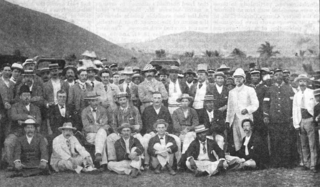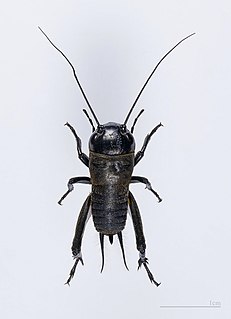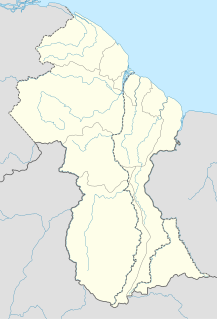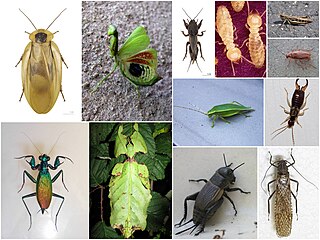
Orthoptera is an order of insects that comprises the grasshoppers, locusts and crickets, including closely related insects such as the katydids and wētā. The order is subdivided into two suborders: Caelifera – grasshoppers, locusts and close relatives; and Ensifera – crickets and close relatives.

The family Gryllidae contains the subfamilies and genera which entomologists now term true crickets. They belong to the Orthopteran subfamily Ensifera, having long, whip-like antennae and has been reduced in terms of the older literature, with taxa such as the spider-crickets and allies, sword-tail crickets, wood or ground crickets and scaly crickets elevated to family level. The type genus is Gryllus and the first use of the family name "Gryllidae" was by Walker.

Ensifera is a suborder of insects that includes the various types of crickets and their allies including: true crickets, camel crickets, bush crickets or katydids, grigs, weta and Cooloola monsters. This and the suborder Caelifera make up the order Orthoptera. Ensifera is believed to be a more ancient group than Caelifera, with its origins in the Carboniferous period, the split having occurred at the end of the Permian period. Unlike the Caelifera, the Ensifera contain numerous members that are partially carnivorous, feeding on other insects, as well as plants.

"The bush" is a term mostly used in the English vernacular of Australia and New Zealand where it is largely synonymous with backwoods or hinterland, referring to a natural undeveloped area. The fauna and flora contained within this area must be indigenous to the region, although exotic species will often also be present.

Roesel's bush-cricket, Roeseliana roeselii is a European bush-cricket, named after August Johann Rösel von Rosenhof, a German entomologist.

A team of amateur cricketers under the captaincy of Robert Slade Lucas toured the West Indies in the 1894-95 season, playing matches between January and April 1895. They played a total of 16 matches of which eight are regarded as first-class. It was the first visit of an English cricket team to the West Indies.

Percy Frank Bush was a Welsh rugby union player who played international rugby for Wales on eight occasions. Playing at fly-half, Bush is regarded as one of the most talented Welsh players of the pre-First World War era.

Tettigonia viridissima, the great green bush-cricket, is a large species of bush-cricket belonging to the subfamily Tettigoniinae.

Trigonidiinae is a subfamily of insects in the order Orthoptera, suborder Ensifera, based on the type genus Trigonidium. They are often referred to as sword-tail crickets, winged bush crickets or trigs.

James Arthur Bush was an English sportsman who played first-class cricket for Gloucestershire and represented England at rugby union.

Crickets are Orthopteran insects which are related to bush crickets, and, more distantly, to grasshoppers. In older literature, such as Imms, "crickets" were placed at the family level, but contemporary authorities including Otte now place them in the superfamily Grylloidea. The word has been used in combination to describe long-recognised unrelated taxa in the suborder Ensifera, such as king crickets and mole crickets.
An England cricket team toured Australia in 1873-74. This was the third tour of Australia by an English team, the previous one being in 1863–64. The team is sometimes referred to as W. G. Grace's XI.

Nsenene is the Luganda name for Ruspolia differens: a bush cricket in the tribe Copiphorini of the 'cone-head' subfamily.

Albion is a village in East Berbice-Corentyne, Guyana.

Meconema is the type genus of bush crickets in the subfamily Meconematinae.

Yorkrakine is a small town in the Wheatbelt region of Western Australia; it is part of the Shire of Tammin, 203 kilometres (126 mi) east of the state capital, Perth. At the 2006 census, Yorkrakine had a population of 117.

Grylloidea is the superfamily of insects, in the order Orthoptera, known as crickets. It includes the "true crickets", scaly crickets, wood crickets and other families, some only known from fossils.

The cohort Polyneoptera is a proposed taxonomic ranking for the Orthoptera and all other Neopteran insects believed to be more closely related to Orthoptera than to any other insect orders. These winged insects, now in the Paraneoptera, were formerly grouped as the Hemimetabola or Exopterygota on the grounds that they have no metamorphosis, the wings gradually developing externally throughout the nymphal stages.

Tettigoniidea is an infraorder of the order Orthoptera, with six extant families.
Karim Vahed FRES is a British entomologist. He is a professor of entomology and senior lecturer in biological sciences at the University of Derby, and is an expert in crickets and bushcrickets (katydids).


















